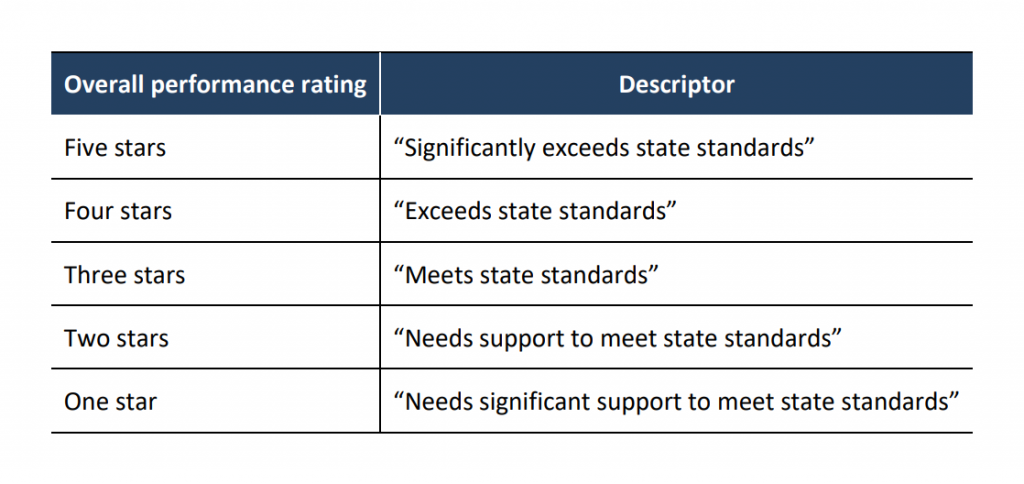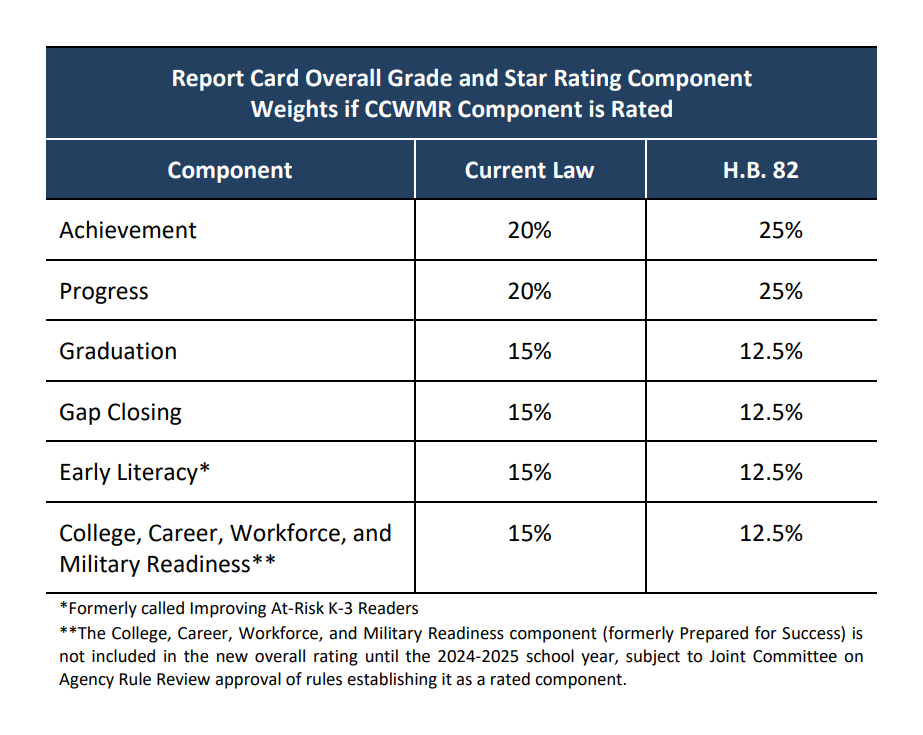Ohio Legislature Finalizes Reform To School District Evaluation System
By: Dylan Theisen
Posted on:
ATHENS, Ohio (WOUB) — The Ohio Legislature passed an ambitious education bill despite a transformative amendment introduced midway through the bill’s life cycle.
Ohio House Bill 82, originally introduced to revise standardized test requirements, will now remedy longtime complaints about the state’s school district evaluation system.
The bill’s initial provisions remain intact, however. It will allow high school juniors to opt out of the annual state-funded ACT exam and remove the state’s ACT/SAT graduation requirement starting with the class of 2023.
The issue stems from students not planning to attend college blowing off a test they did not need to take.
To many administrators, including Federal Hocking Superintendent David Hanning, this decision was a no-brainer.
“We have a significant number of students – I think it’s better than 50% – that don’t go to college,” Hanning said. “You know, they get a job and they go right out into the workforce.”
The state had been spending $4.9 million every year to administer these tests. Meanwhile, hundreds of universities – including Ohio University – are no longer requiring the ACT through new, ‘test-optional’ admission policies.
Most notably, students’ apathy toward standardized tests has a direct impact on school report cards — an annual performance rating which in turn affects economic development and homeownership.
For those reasons, the Ohio House unanimously passed that version of the bill earlier this month. But when introduced on the Senate floor, the bill was significantly amended to address the controversial district report cards.
With the help of Senate Primary and Secondary Education Committee Chair Andrew Brenner, the amended bill became a far more ambitious one.
“The current [report card] isn’t fair,” Brenner said. “It does not demonstrate or show progress that’s being made in the schools, especially schools where you’ve got a lot of economically disadvantaged students.”
It’s a reform that’s been in bipartisan discussion for more than two years, according to Brenner.
The amendment was pulled from legislation that’s long been dormant. Meanwhile, bill sponsors were working with teachers’ unions, administrative organizations and schools from across the state to improve a complicated evaluation system.
But why now, and why add it to this bill?
“We came to this agreement realizing that we wanted a new report card ready for the next school year,” Brenner said. “And that’s why we spent countless hours on the phone, in meetings, working on this over the last several weeks.”
Brenner believed attaching the provisions of past legislation to a bill that had lots of bipartisan momentum would help complete the process as quickly as possible.
“I think people know that there was plenty of public process, and a lot of process for the various school organizations to come in and testify,” Brenner said.
One of those testimonies was submitted locally from Fort Frye High School in Washington County.
Superintendent Stephanie Starcher opposed the previous legislation. She said, however, the bill’s sponsors have addressed many of her concerns and she now believes the amendment is a step in the right direction.
“I know that Rep. Jones and Sen. Brenner both are genuinely interested in improving the report card system and have worked really hard and listened to educators about this,” Starcher said.
Hanning and Starcher are among the majority of superintendents who have long complained that the system fails to compensate for districts with limited resources, reduces students to a single standardized test score and does not credit schools for improving on past shortcomings – all the while being too difficult to understand.
“They have a 40-page document that tells you how to read the report card. So, if you’ve got to sit down with a 40-page document in order to get anything out of this, I think it is a waste of taxpayer dollars,” Hanning said.
Hanning also spoke extensively on the challenge of supporting students struggling at home – a challenge that particularly affects regions of southeast Ohio. These efforts go unrecognized by the legislature’s current report card.
“Kids come through the doors every morning with whatever they left home with. So whatever emotional baggage that they had, whatever trials and tribulations. And then we spend a lot of time trying to help those kids work through that just so that they’re ready to learn,” Hanning said. “It’s just one of those things that people don’t understand unless they come and see what it actually looks like.”
The report card system will undergo a complete overhaul with the recent amendment.
Most notably, district evaluations will now account for data regarding available resources – such as student-staff ratio, course offerings and technology and transportation availability.
The new report card will utilize a star rating system complete with descriptions of each component and their ratings, along with trend arrows to emphasize growth over time.

“Not everything in this bill everybody agrees to,” Brenner said. “But we felt that we needed a compromise and we needed something where we’re moving the ball forward that I think every school district will agree to is a better system.”
The bill quickly passed through the Ohio Senate and the House later confirmed its amendments by an 89-3 vote.
If the governor signs it into law, the new system will take effect for the 2021-22 school year. A review committee would be established for possible revision after the 2022-23 school year.
“It’s definitely an improvement over the current report card system,” Starcher said. “You know, I’m going to take what we can get at this point. And I just hope that we will have legislation that says the report card system is required to be reviewed [every so often].”

Although Superintendent Hanning is optimistic for a more inclusive report card ahead, he said the state has a long way to go before district evaluations are truly fair.
“It’s difficult to put a statewide grade card in place when we haven’t yet addressed all the inadequacies and inequities between school districts. And until we do something to fix that, the grade card’s not going to be a fair reflection.”
A summary of all changes to the report card is listed below, or a full analysis of the new system is available through the Ohio Legislature.
REPORT CARD CHANGES
-
5-star rating system: Replaces the previous letter grades, upon which individuals subconsciously attribute the 0-100 scale. Eliminates data for subcomponents while the data will continue to be reported.
-
Additional context: Includes text descriptions to supplement the star system, colors to add clarity to the value of each rating. Trend arrows show whether a school’s performance is improving or declining within a component.
-
Overall rating: Maintains the overall district and building ratings, while introducing half-stars to allow for further differentiation.
-
Student Opportunity Profile Measure: ratings will take into account reported data regarding opportunities provided — such as student:staff ratio, course offerings, and technology and transportation availability.
-
Weight redistribution: The calculated weight of each component has been revised to ensure credit is given for both achievement and growth, not just one or the other.
-
Gap Closing component: Restructured to reassure representation of all student groups and measure the educational growth of vulnerable students based on income, race, ethnicity, disability, absenteeism
-
Achievement component: Ensures districts and schools are evaluated against an attainable standard by setting the maximum performance index (P.I.) score at the average of the highest 2% of districts and schools. Measures both achievement and growth rather than just one or the other.
-
Progress component: Now graded on a three-year average, designed to ensure that one bad year won’t sink a school’s rating. Weight of this component increased to be fairer to high-poverty schools.
-
Graduation Rate component: Includes students who achieve five-year graduation, in addition to those on the traditional four-year pathway, to ensure schools get credit for helping students who fell behind
-
Early Literacy component: Restructured to give credit for promotion and improvement of struggling readers – as well as incorporating proficiency rates for those students deemed proficient.
-
College, Career, Workforce & Military Readiness: The bill reworks the former Prepared for Success component and introduces a range of options to demonstrate preparedness — dual enrollment, vocational school completion, apprentice and internship programs, military enlistment — in addition to ACT/SAT scores. This component will not be rated for the first three years of the system.
-
New end-of-course exams: Biology, American History, and American Government exams introduced for a broader range of subjects in the P.I. calculation

